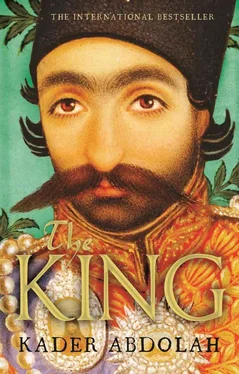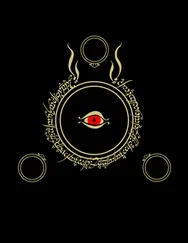Dedicated to the two most distinguished Persian prime ministers of the late nineteenth century:
Mirza Abolghasem Ghaemmagham Farahani
and
Mirza Tagi Khan Amir Kabir
The shah
Mahdolia, mother of the shah
Taj Olsultan, daughter of the shah
Mirza Kabir, the grand vizier, the prime minister
Sheikh Aqasi, the shah’s spiritual vizier
Jamal Khan, leader of the resistance group
Mirza Reza, Jamal Khan’s right-hand man

In the tea houses of Persia, tales of the ancient kings have been the constant fare of storytellers for the last thousand years. The storytellers played fast and loose with chronology and gave their fantasy free rein so the history they depicted would be strong and colourful. They relocated events, made the occasional omission and sometimes added a thing or two.
They were elaborating on the narrative art that had been perfected by the great medieval Persian storytellers. When the Persian Empire fell fourteen centuries ago, however, the stories also came to an end. Persian pride was dealt a fatal blow.
But then life brought forth the poet Ferdowsi. Ferdowsi wrote a great book called the Shahnameh , or The Tales of the Kings . In order to cover the vast number of events that had taken place in the former kingdom, Ferdowsi created the hero Rostam. He had Rostam live for about nine hundred years, thereby rescuing the nation’s lost heritage from oblivion.
The teller of this story is following in that poet’s footsteps.
In the beginning was the Cow, and the Cow was with God, who bore the name Ahura Mazda.
The Cow did not yet produce milk. Ahura Mazda blessed the Cow, saying, ‘We have appointed no one to have dominion over you. We have created you for those who care for the four-footed beasts and for those who tend their pastures.’
A few thousand years later, life brought forth the man Kayumars. One evening, as Kayumars was standing near his cave, he looked up at the stars and the moon, casting their light on the cattle and people in the never-ending pastures. ‘Someone should take command of this mystery,’ he thought.
As he was standing once again near the mouth of his cave on a sunny afternoon, dark clouds appeared without warning and torrential rain began to fall. Churning rivers destroyed the pastures and swept away people and cattle alike.
‘Someone should take command of the rivers,’ Kayumars thought.
On another day he saw the men fighting and beating each other to death with sticks. He saw that the women were afraid and the children were crying, and he said to himself, ‘Someone should take command of those men, and protect the women and children.’
One morning, just as the sun was coming up, the women and their children came to him and gave him a crown of young branches and fragrant blossoms. He put the crown on his head, stretched out his arms to the sky and spoke the following words: ‘Ahura Mazda! Grant me your strength, that I might take command of everything that is motionless and everything that moves upon the earth.’
Then he went down from the mountain.
Kayumars reigned for seven hundred years. Many kings came after him. One of them was Astyages, the king of the Medes and ruler over the Persians. Astyages had a dream that a grapevine grew out of the belly of his daughter Mandane, casting a shadow over the whole world. He asked his dream interpreters what this could mean. They said that his daughter, who was the wife of a prince of the subjected Persians, would bear a son who would topple the king from his throne.
Astyages ordered that as soon as his daughter gave birth to a son, the child be put to death. But the child, who had been named Cyrus, was secreted away to be raised by a shepherd. Later, when Cyrus was fully grown, he killed Astyages and became the new king.
Cyrus conquered the whole world during his reign. He left behind a clay tablet bearing the following words written in cuneiform script: ‘I am Cyrus, king of the world, great king, mighty king, king of Babylon, king of Sumer and Akkad, king of the four quarters.
‘All the kings who sit upon thrones, from the Upper Sea to the Lower Sea, and those who live in districts far off, and the kings of the West who dwell in tents, all of them brought their heavy tribute before me and in Babylon they kissed my feet.’
Cambyses, the son of Cyrus, succeeded his father. After Cambyses there were three more kings until Darius the Third came to power. He established a strong empire on which the sun never set, and he built a network of new roads that brought together all the corners of his kingdom. He then decided to conquer Greece. Commanding an army of Indians, Ethiopians, Moschians, Thracians, Kissians and Assyrians, he entered the harbour of Athens.
Greece was terrified by his divine presence. The Greeks knew they could never win the war, but the gods were on their side. Defying all expectations, they broke the invincible army of the Persians and the king fled.
The flight of Darius the Third was an embarrassment to the gods of the East. They would sooner have seen him fall in battle, be taken prisoner or be hacked to pieces — anything but fleeing. There is an old saying that perfectly sums up what Darius did: a dead lion is still a lion, a wounded lion is a lion too, and a captured lion in a cage is a lion nonetheless. But a lion that flees from his enemy is not a lion.
After this the gods turned their backs on the kings of Persia and the decline of the empire began.
Later Alexander the Great dealt a staggering blow to the Persian Empire. He set all the palaces on fire and plundered the vast royal coffers. Then he left for India to subjugate that land as well.
A few centuries after this the Muhammadans, with their freshly written Quran, descended on the weakened Persian Empire. They managed to seize power in three weeks. The deposed king, Yazdegerd, mounted his horse and galloped to the farthest eastern border, to Herat. There he planned to revive his disintegrated army and to drive the Arabs from his land. Deep in the night, the exhausted king sought rest at a mill. The miller strangled him in his sleep and stole his royal robes and jewels. Thus the great Persian Empire was brought to an end by a miller.
Later still Genghis Khan journeyed from east to west, laying such waste to the land of the Persians that nothing remained of its former glory. It wasn’t until the Safavids came to power that Persia underwent a revival, but it was short-lived. The land fell into decline. The tribes fought each other for power.
At the beginning of the nineteenth century one of those tribes succeeded in gaining control.
This story is about one king of that tribe: Prince Naser.
Once upon a time there was a Persian prince who later on, after he had become king, went to visit Paris.
While meeting with a group of French businessmen he was introduced to the engineer Gustave Eiffel. No one suggested they go and see the great iron tower, however, since neither the city council nor the people of Paris were particularly happy with that useless pile of scrap.
The prince’s official name was Naser Muhammad Fatali Mozafar. These were the first names of his father, his grandfather, his great-grandfather and his great-great-grandfather.
Читать дальше













